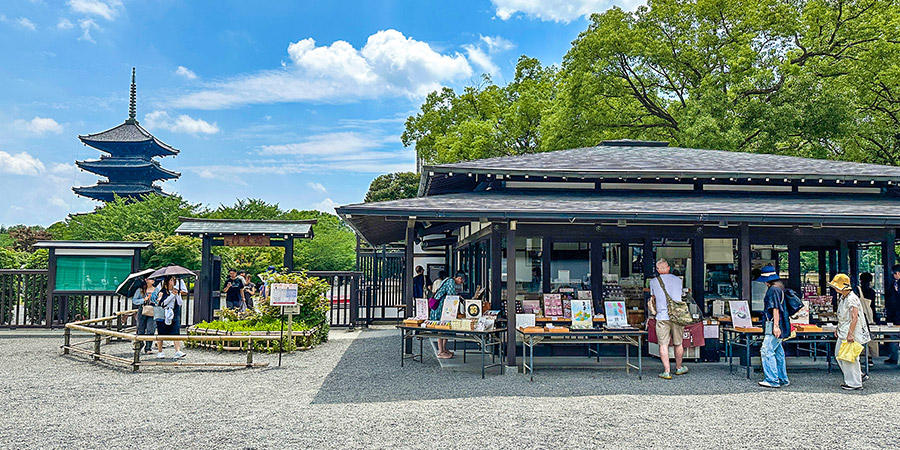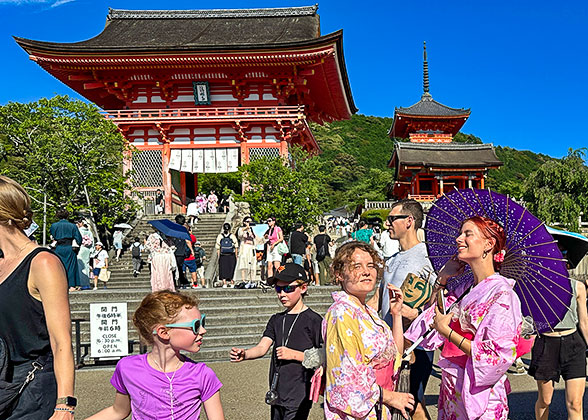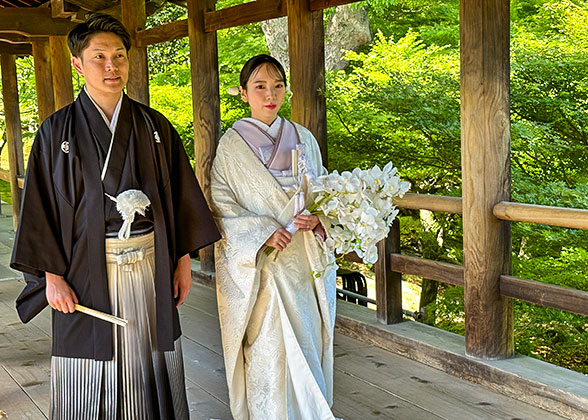Toji Temple
Built 1,200 years ago after Kyoto became the capital (794 - 1868) of Japan, Toji, the East Temple, together with Saiji, the West Temple, were commissioned by the then Japanese emperor to guard the entrance to the city against evil. However, Toji was the only one surviving to this day, for the efforts of Monk Kukai (774 - 835) who made it the center of Esoteric Buddhism, as well as the faithful support of him from both the imperial family and Japanese people. For its significance in Japan’s Buddhist history, Toji has been listed as a UNESCO World Heritage Site.

Toji Temple
|
Toji’s Flea Market on 21st of Each Month
An envoy to Tang-dynasty (618 - 907) China who brought back Esoteric Buddhism, Kukai had greatly contributed to Japanese Buddhism and thus was - and still is - venerated across Japan. To commemorate his passing on March 21, there was once a market at Toji where people would trade 1 copper coin for a cup of tea on the same day; now it has developed to a huge flea market held on 21st of each month, when there will be over a thousand stands selling ceramics, antiques, used clothes, and other various kinds of things.Landmarks of Toji Temple
Kodo, the Lecture Hall Revealing the Universe of Esoteric Buddhism
Kukai built Kodo at the center of Toji as soon as he was honored by the emperor to become the head priest of Toji in 823. Inside, he placed 21 Buddha to form a Mandala, a pattern design embodying the universe of Esoteric Buddhism. Dainichi Nyorai, the central Buddha of the school, is at the very center of Mandala.
|
|
|
Kondo, the Main Hall and the Largest Building of Toji
Across from Kodo to the south, Kondo enjoys the most magnificent architecture here with an Indian influence. In it sit Yakushi Nyorai, the Buddha of Medicine, in the center and two Bodhisattvas on either side, each representing Sun and Moon shining holy lights into the world of suffering.

Kondo Hall
|
Five-storied Pagoda, the Tallest Pagoda in Japan

Toji Temple's Pagoda
|
Miedo, Where Monk Kukai Lived and is Still Served
Miedo was the residence of Monk Kukai to the northwest of Kodo, with an aristocratic look totally different from other temple buildings. In memory of Kukai, every 6:00 in the morning, people would serve meal and tea before his statue housed within, as if he’s still alive and ready to eat; relics of Buddha Kukai brought from China would also be put on the head and in the palms of hands of his followers. This service can be participated by any visitors.Homotsukan, the Treasure House of Toji
Constructed in 1963, Homotsukan is the treasure house of both Toji and Japanese Esoteric Buddhism, northwest of Kodo. This is where to find 20,000 relics, all listed as National Treasures and Important Cultural Properties. Themed exhibitions of selected relics are held here in each spring (March 20 – May 25) and autumn (September 20 - November 25).A Special Cherry Tree by Ticket Office
South of the ticket office there is a cherry tree, special for being planted into the earth piled up on the ground - any excavations here have been forbidden since Toji became a national historical site. Visitors can choose an angle to include the beauty of the tree and the pagoda into one photo.
|
|
|
Opening Hours and Fee
Open:March 20 – April 17: 8:30 am – 4:30 pm;
April 18 – September 19: 8:30 am - 5:00 pm;
September 20 - March 19: 8:30 am – 4:00 pm
Admission fee:
General: 500 yen;
Extra fee for visiting the first floor of the pagoda: 300 yen;
Extra fee for visiting Homotsukan: 500 yen
|
|
|
How to Get There from Kyoto Station?
On foot:Walk 15 minutes southwest from the Hachijo-Exit of Kyoto Station.
By train:
Take the Kintetsu Line, get off at Toji Station, and walk 10 minutes.
Nearby Attractions
Kyoto Railway Museum (1.2 km/0.7 mi away, 17 min’s walk): Kyoto Railway Museum is the No.1 place to go if you are curious about the history of Japan’s mammoth railway systems. It displays 54 retired trains spanning a century, dioramas and documents, and provides lots of interactive funs.You May Like
-
 7 Days Best Private Tour in Japan: Tokyo - Mount Fuji - Tokyo - Kyoto - Nara - Osaka from USD2401
7 Days Best Private Tour in Japan: Tokyo - Mount Fuji - Tokyo - Kyoto - Nara - Osaka from USD2401 -
 8 Days Panoramic Japan Mini Group Tour to Tokyo - Hakone & Mt. Fuji - Kyoto - Nara - Osaka - Hiroshima - Osaka from USD2771
8 Days Panoramic Japan Mini Group Tour to Tokyo - Hakone & Mt. Fuji - Kyoto - Nara - Osaka - Hiroshima - Osaka from USD2771 -
 11 Days Mini Group Tour to Tokyo - Hakone (Mt. Fuji) - Kyoto - Nara - Osaka - Hiroshima - Kanazawa - Shirakawa-go - Takayama - Tokyo from USD3554
11 Days Mini Group Tour to Tokyo - Hakone (Mt. Fuji) - Kyoto - Nara - Osaka - Hiroshima - Kanazawa - Shirakawa-go - Takayama - Tokyo from USD3554

